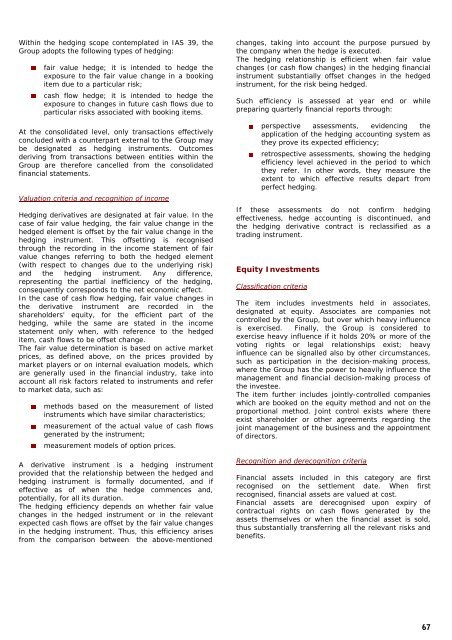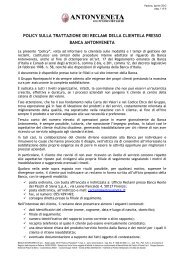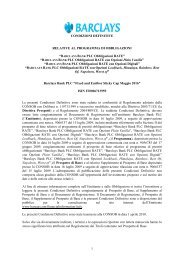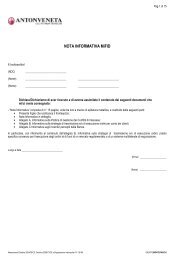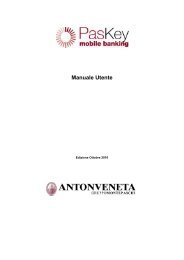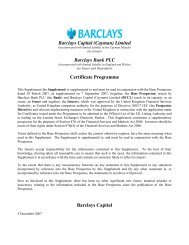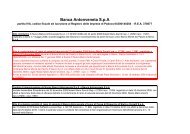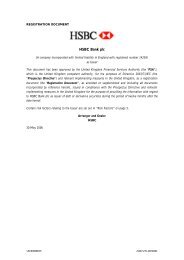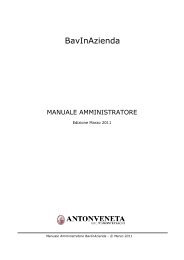996 - Banca Antonveneta
996 - Banca Antonveneta
996 - Banca Antonveneta
You also want an ePaper? Increase the reach of your titles
YUMPU automatically turns print PDFs into web optimized ePapers that Google loves.
Within the hedging scope contemplated in IAS 39, theGroup adopts the following types of hedging:fair value hedge; it is intended to hedge theexposure to the fair value change in a bookingitem due to a particular risk;cash flow hedge; it is intended to hedge theexposure to changes in future cash flows due toparticular risks associated with booking items.At the consolidated level, only transactions effectivelyconcluded with a counterpart external to the Group maybe designated as hedging instruments. Outcomesderiving from transactions between entities within theGroup are therefore cancelled from the consolidatedfinancial statements.Valuation criteria and recognition of incomeHedging derivatives are designated at fair value. In thecase of fair value hedging, the fair value change in thehedged element is offset by the fair value change in thehedging instrument. This offsetting is recognisedthrough the recording in the income statement of fairvalue changes referring to both the hedged element(with respect to changes due to the underlying risk)and the hedging instrument. Any difference,representing the partial inefficiency of the hedging,consequently corresponds to the net economic effect.In the case of cash flow hedging, fair value changes inthe derivative instrument are recorded in theshareholders' equity, for the efficient part of thehedging, while the same are stated in the incomestatement only when, with reference to the hedgeditem, cash flows to be offset change.The fair value determination is based on active marketprices, as defined above, on the prices provided bymarket players or on internal evaluation models, whichare generally used in the financial industry, take intoaccount all risk factors related to instruments and referto market data, such as:methods based on the measurement of listedinstruments which have similar characteristics;measurement of the actual value of cash flowsgenerated by the instrument;measurement models of option prices.A derivative instrument is a hedging instrumentprovided that the relationship between the hedged andhedging instrument is formally documented, and ifeffective as of when the hedge commences and,potentially, for all its duration.The hedging efficiency depends on whether fair valuechanges in the hedged instrument or in the relevantexpected cash flows are offset by the fair value changesin the hedging instrument. Thus, this efficiency arisesfrom the comparison between the above-mentionedchanges, taking into account the purpose pursued bythe company when the hedge is executed.The hedging relationship is efficient when fair valuechanges (or cash flow changes) in the hedging financialinstrument substantially offset changes in the hedgedinstrument, for the risk being hedged.Such efficiency is assessed at year end or whilepreparing quarterly financial reports through:perspective assessments, evidencing theapplication of the hedging accounting system asthey prove its expected efficiency;retrospective assessments, showing the hedgingefficiency level achieved in the period to whichthey refer. In other words, they measure theextent to which effective results depart fromperfect hedging.If these assessments do not confirm hedgingeffectiveness, hedge accounting is discontinued, andthe hedging derivative contract is reclassified as atrading instrument.Equity InvestmentsClassification criteriaThe item includes investments held in associates,designated at equity. Associates are companies notcontrolled by the Group, but over which heavy influenceis exercised. Finally, the Group is considered toexercise heavy influence if it holds 20% or more of thevoting rights or legal relationships exist; heavyinfluence can be signalled also by other circumstances,such as participation in the decision-making process,where the Group has the power to heavily influence themanagement and financial decision-making process ofthe investee.The item further includes jointly-controlled companieswhich are booked on the equity method and not on theproportional method. Joint control exists where thereexist shareholder or other agreements regarding thejoint management of the business and the appointmentof directors.Recognition and derecognition criteriaFinancial assets included in this category are firstrecognised on the settlement date. When firstrecognised, financial assets are valued at cost.Financial assets are derecognised upon expiry ofcontractual rights on cash flows generated by theassets themselves or when the financial asset is sold,thus substantially transferring all the relevant risks andbenefits.67


